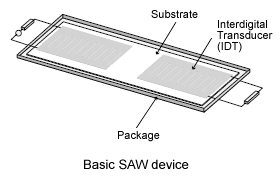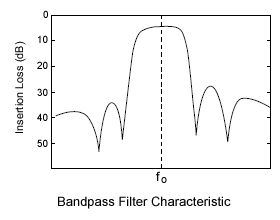Saw Applications for Telecommunications
Definition of Saw
Surface Acoustic Wave (SAW) is a wave propagating along the surface of an elastic substrate. Frequency of Saw is:
F = V / λ
Where V is the velocity of SAW (~3,100m/s), λ is the IDT period.
Types of Saw Devices

Figure-1 - Basic Saw Device
The device in (Figure-1) is a basic delay line, because the wave takes some time to travel between the transducers - typically 1 μs for 3 mm of path length. This is very compact compared with EM waves which, in free space, need 300 m of path for 1 μs delay. The device can also be used as a bandpass filter, because the transducers operate most effectively when the saw wavelength equals the transducer pitch - at other frequencies the waves generated by individual gaps are not in phase, so the wave amplitude falls off as the frequency is changed.
Another basic device is the resonator. This uses arrays of metal strips, with pitch λ/2, as reflectors of the waves. These arrays can give strong Saw reflections, and two arrays can be used to form a saw cavity with high Q, up to 105. Such resonators are often used for high-stability oscillators.
The above devices are just some basic types. Many unique variations are possible for saw devices, and their applications range from piezoelectric strain gauges to pulse compression radar, to cellular handsets.

Figure-2 - Bandpass Filter Characteristic
The most common group are bandpass filters, which are in very widespread use in radio systems (including mobile phone handsets and base stations) and in domestic TV. There are many types with differing advantages, such as low shape factor, low insertion loss, small size, or high-frequency operation. The wide variety of types is possible because almost arbitrary shapes can be defined on the surface with very high precision, using lithography techniques similar to those for semiconductor processing. A typical saw Bandpass characteristic is shown if (Figure-2).
Saw Applications
Surface acoustic wave filters play a key role in telecommunications. Because of their special features various products are being used more and more in different transmission systems:
- Passband filter typically as RF or IF filters for data processing in communication systems. A few examples for these applications are mobile phone basestations, point to multipoint systems, radio link systems, Professional Mobile Radio (PMR) systems and Wireless Local Loop (WLL) systems.
- Clock recovery filters for digital regeneration in fiber-optic systems, e.g. FDDI, ISDN, LAN, etc.
- Nyquist and Vestigial sideband filters in television transmission systems in TV transmitters and high quality receivers, modulators/demodulators, and converters of CATV head-ends, etc.
- Passband filters for basestations include filters for all worldwide standards (TDMA, CDMA, GSM, and W-CDMA). Filters for WLL systems are available for products based on CDMA, W-CDMA, DECT, GSM, and proprietary standards. Trunked radio filters for PMR basestation, mobile and handheld applications are offered for the digital standard TETRA.